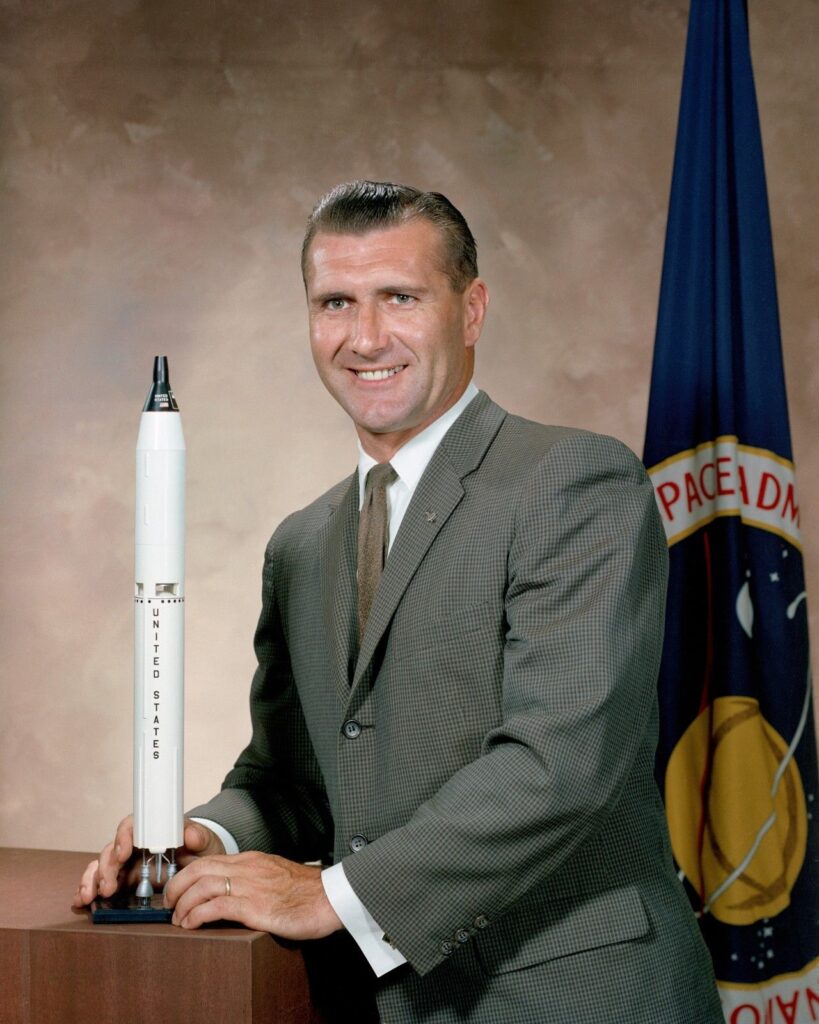Command Module pilot on Apollo 12, the second lunar landing mission.
Richard F. Gordon Jr. was born on October 5, 1929, in Seattle, Washington. A graduate of North Kitsap High School in Poulsbo, Washington, Gordon received a Bachelor of Science degree in Chemistry from the University of Washington in 1951 and an Sc.D (honorary) from Niagara University in 1972.
Richard Gordon received his wings as a naval aviator in 1953. He attended All-Weather Flight School and jet transitional training then was assigned to an all-weather fighter squadron at the Naval Air Station, Jacksonville, Florida. He graduated from the Navy’s Test Pilot School at Patuxent River, Maryland in 1957, and was a flight test pilot there until 1960. He then served with Fighter Squadron 121 at the Miramar, California Naval Air Station as a flight instructor in the F-4H and participated in the introduction of that aircraft to the Atlantic and Pacific fleets. He also was flight safety officer, assistant operations officer, and ground training officer for Fighter Squadron 96 at Miramar. He won the Bendix Trophy Race from Los Angeles to New York in May 1961, setting a new speed record of 869.74 miles per hour and a transcontinental record of two hours and 47 minutes. He is a 1963 graduate of the Operations Analysis, U.S. Navy Post-Graduate School in Monterey, California and has logged more than 4,500 hours flying time, including 3,500 hours in jet aircraft.
NASA selected Gordon as an astronaut in 1963. He made his first space flight as Pilot on the three-day Gemini XI mission, launched Sept. 12, 1966. He and Command pilot Charles Conrad, Jr. tracked down and docked with an Agena satellite in earth orbit. Gordon left the spacecraft for a planned 115-minute extravehicular activity (EVA), but he had to cut it short after 44 minutes because of difficulty maintaining his position in weightlessness without handholds or foot restraints, a valuable lesson for later spacewalkers. Gemini XI later used the Agena engine to rocket to a then-record altitude of 850 miles.
On November 14, 1969, Gordon re-entered space as the Command Module pilot on Apollo 12. Man’s second lunar landing mission also included Charles Conrad (Spacecraft Commander) and Alan L. Bean, Lunar Module pilot. Throughout the 31-hour lunar surface stay by Conrad and Bean, Gordon remained in lunar orbit aboard the command module, Yankee Clipper, taking mapping photographs of tentative landing sites for future missions. He also performed the final re-docking maneuvers following the successful lunar orbit rendezvous, which was initiated by Conrad and Bean from within lunar module Intrepid after their ascent from the Moon’s surface on November 20.
In addition to meeting all of the mission’s objectives, Apollo 12 achieved the first precision lunar landing with Intrepid’s touchdown in the Moon’s Ocean of Storms; the first lunar traverse by Conrad and Bean as they deployed the Apollo Lunar Surface Experiment Package, installed a nuclear power generator station to provide the power source for these long-term scientific experiments, gathered samples of the lunar surface for return to earth, and completed a close up inspection of the Surveyor III spacecraft. The later had soft-landed on the Moon in April 1967. More than 244 hours and 36 minutes after lift-off, Apollo 12 concluded with a Pacific splashdown and recovery operations by the USS Hornet on November 24, 1969. With the end of his second mission, Richard Gordon logged a total of 315 hours and 53 minutes in space, including two hours and 44 minutes in EVAs.
In 1971, Gordon served as backup Spacecraft Commander for Apollo 15 then retired from NASA and the Navy, with the rank of captain, in January 1972. He has been awarded the NASA Distinguished Service Medal, NASA Exceptional Service Medal, two Navy Distinguished Flying Crosses, Navy Astronaut Wings, the Navy Distinguished Service Medal, Institute of Navigation Award for 1969, Godfrey L. Cabot Award in 1970, the Rear Admiral William S. Parsons Award for Scientific and Technical Progress, 1970; NASA’s MSC Superior Achievement Award; NASA’s Group Achievement Award; the FAI Record in 1961 for the Transcontinental Speed Record; and the FAI World Record for the Altitude Record set during Gemini XI.
Since retirement Richard Gordon has served as Executive Vice President of the New Orleans Saints Professional Football Club in the National Football League; General Manager of Energy Developers, Limited; involved in a joint venture with Rocket Research Corporation for the development of a liquid chemical explosive for use in the oil and gas industry; and President of Resolution Engineering and Development Company (REDCO) which provided design and operational requirements for wild oil well control and fire fighting equipment onboard large semi-submersible utility vessels.
Following REDCO’s merger with Amarco Resources, Gordon assumed the additional duties of Vice President of Marketing, Westdale, an oil well servicing subsidiary of AMARCO operating in North Central Texas and Oklahoma, and also served as Vice President for Operations, Texas Division before serving as Director, Scott Science and Technology, Inc., Los Angeles Division. In March 1982, he became President of Astro Sciences Corporation. This company provides a range of services including engineering, project management, project field support teams, to software and hardware system design for control room applications. In 1984, Gordon was a Technical Advisor for and played the part of “CapCom” in the CBS mini-series “Space” by James A. Michener.
On November 19, 2005, Captain Richard Gordon received NASA’s Ambassador of Exploration Award, given to the 38 Mercury, Gemini, and Apollo astronauts. The award includes a Moon rock in recognition of the dedication and courage of America’s first astronauts. Gordon and other “Award recipients help NASA communicate the benefits and excitement of space exploration, and they encourage the next generation of explorers.”

